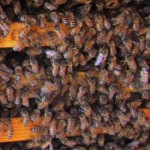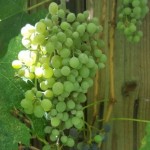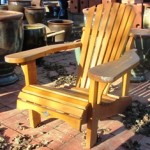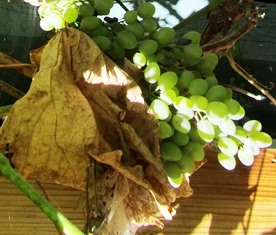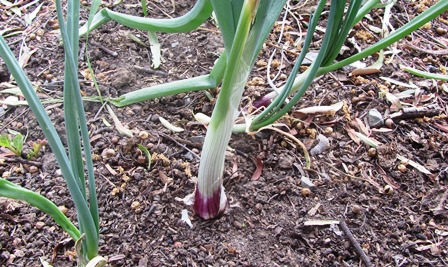Four Reasons to Buy Bare-Root Plants
Mid-February marks the beginning of bare-root season in the Bay Area. Growers ship roses, fruit trees, grapes, and berries in late January through February and March to local nurseries and DIY garden centers. By April, often sales of unsold bare-root plants begin. There are at least four good reasons to buy bare-root plants before spring officially arrives.
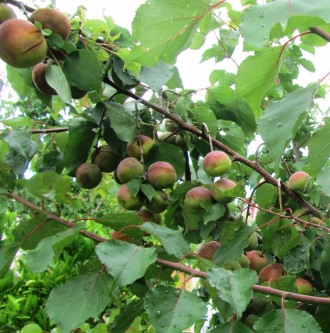
- When you buy bare-root trees, berries, grapes, and other plants in late winter (here in the Bay Area), you’ll pay less for them than you will if you wait until the start of spring. The purchase price increases later in the season. When the plants begin leafing out, nurseries will place unsold bare-root plants in pots. Potting an unsold plant involves extra labor as well as the costs for the pot, soil and amendments, mulch, and possibly stakes. Those costs are passed to the shopper.
2. It’s easy to place a bare-root tree right into your garden before its sap is flowing. When it is still “asleep,” it’s not as susceptible to cold and and won’t need as much water as it will when the weather is warm, the plant has leafed out, and the roots are growing and spreading.
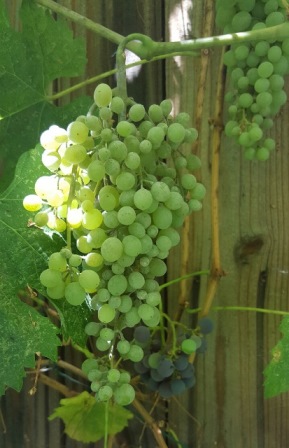
varieties of bare-root grapes.
3. Bare-root buys you time. If you are still planning your garden, you can “heal in” a bare-root plant until you are ready to put it in your garden. You just need to excavate a trench in which you temporarily place the bare-root plant. Mound soil over the roots and water. Let the plant rest until you prepare the permanent planting hole.
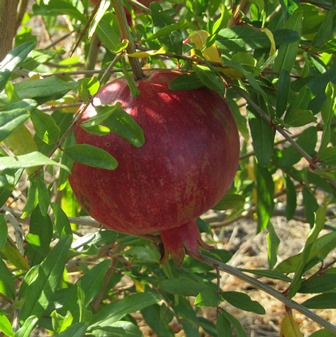
popular because they remain small and fruitful for years.
4. You have an opportunity you won’t get again to inspect the health of the root and its growth. With a bare-root plant, the roots can be examined for problems such as decay or damage. Using sharp pruning shears, you can cut away problem issues. When you buy an already potted plant, you won’t have this option.
Take a moment to visit your local plant seller, nursery, or DIY center to see what plants are available right now. Enjoy the season.

and after three years is producing dozens of late summer pears.
If you enjoy reading about country living topics, check out Meera Lester’s Henny Penny Farmette mystery series. Besides an entertaining mystery, each book includes delicious recipes, strategies for growing heirloom vegetables and fruits, and tips for keeping chickens and bees. These novels and her nonfiction self-help and wellness books are available online and everywhere books are sold.
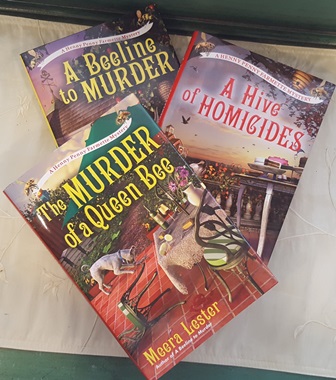
Three Reasons to Plant Bare Root
If you are someone like me who loves to garden, you have the first day of spring circled on your calendar. For 2020, spring arrives on March 19.

Plant bare root fragrant roses and engage in mindfulness practice. Both will have you stopping to smell the roses
Bare-root season (when fruit trees, roses, and other plants are dormant and sap is not flowing) is now. Here in the Bay Area, the soil is currently soft and makes for easy turning with a spade. Now is the time to incorporate some roses or other bare root plants into your garden. There are several reasons to do so.
1. Planting bare root saves you money. If you are buying from a local nursery or a seller who ships, you’ll find the cost cheaper because you’re not paying for soil or containers.
2. Better selection. You can purchase heirloom varieties of deciduous trees and shrubs from all over the world when you buy bare root. Bare root fruit trees are popular with back yard gardeners but you might also consider artichokes, rhubarb, strawberries, grapes, asparagus, and many other plants that are sold as bare root.
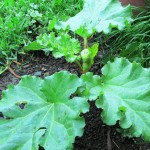
Rhubarb is a bare root plant that flourishes in rich soil with some protection against direct overhead sun
3. You have flexibility. Planting in February just before spring means the ground has thawed in areas where freezing temperatures are the norm. When the ground is growing warmer and is workable is the time to tuck your bare root plants into the soil.
________________________________________________________________________
If you enjoy reading about country living topics, check out my Henny Penny Farmette series of cozy mysteries, including A BEELINE TO MURDER, THE MURDER OF A QUEEN BEE, and A HIVE OF HOMICIDES (Kensington Publishing). These mysteries also include farm to-do lists and delicious recipes.
I’ve also written over two dozen self-help and wellness books, including THE SELF-CARE PLANNER, HOW TO LIVE WITH INTENTION, and MY POCKET MEDITATIONS (Adams Media/Simon and Schuster).
Find Meera Lester’s books online and in traditional bookstores everywhere. Barnes & Noble will be featuring THE SELF-CARE PLANNER on its self-care table for the New Year, New You promo, starting Dec. 31 and running through March 2020, in select stores.
https://www.simonandschuster.com/books/The-Self-Care-Planner/Meera-Lester/9781507211649?utm_source=author_post&utm_medium=adams_outlet&utm_campaign=adams_lead_fall&utm_content=
Swarms of Honeybees Mark an Early Start to Spring
On my birthday in late March this year, I noticed a large swarm of honeybees in my neighbor’s yard. The weather was warm and perfect for the overpopulated hive to release some of its citizens to find a new home with their new fertile queen.
Then on April 8–Easter Sunday, my own Italian honeybees swarmed. Our hive had made it through the winter although the bees had battled hive beetles. But just as hubby and I were on ladders that Easter afternoon building a new trellis for our grapes, I heard the low hum of thousands of bees lifting skyward.
Sure enough, the new swarm had emerged from our hive. We dropped our drills, screws, and lumber. He banged on cooking pot with a wooden spoon (to disorient the bees and encourage them to land in a nearby tree) while I set up the extra hive box with empty frames.
Suited up in beekeeper gear, my hubby clipped a couple of branches from the pin oak tree to make it possible to do a hard shake on the one limb the bees had coalesced around. He placed the prepared hive box beneath the tree. Our beekeeper neighbor joined us and helped. Then, a hard shake and boom…the entire colony dropped into the hive box.
We waited until after dark to ease the hive box lid in place and then take the entire box to its permanent location in a sunny, dry spot in the garden.
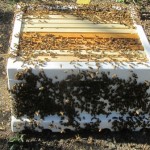
A hive box without its lid. The bees do a waggle dance to tell the bees still in the air that this is their new home
The work on the trellis that will serve as our grape arbor was nearly complete when the swarm occurred. Now the finishing touches will have to wait for another day.
Springtime Projects on the Farmette
After weeks of rain, Mother Nature has put on a robe of splendor. Warm weather has arrived. Already, my beekeeper neighbor has had his honeybee hives send out three swarms.
My own bee population seems to be swelling. I’ve fished out my swarm catcher, primed it with scented lemon oil, and placed in among the blossoms in a nearby apricot tree. I may be blessed with a swarm as well.
There are plenty of other springtime projects to attend to here on my farmette. I’ve got to reassemble my temporary grape arbor. Each year, I think we’ll build a permanent structure, but there never seems to be enough time.
My cell flats have organic plants up now and ready for placing in my garden or raised beds. I’d like to add some more chicken manure to the strawberries since they are rapidly growing and producing small fruit.
Other plants need a spring feeding–the citrus, apples, and apricots, for example. I usually do the feeding before the trees break bud, so I’m a little late.

This candy-stripe rose was a gift from a friend–a cutting from her rose that became a large bush in my care
I will be turning the compost pile and mulching all my rose bushes (which have already leafed out and are setting buds). Finally, I’d like to put up a couple more bird houses (mating is already in the air) and fill my hummingbird feeders.
- This–my original flock–was massacred by a wild predator, fox or coyote, last year
I need to purchase baby chicks from the feedstore to start my new flock. Hubby and I will build a new, reinforced chicken run and expand the existing hen house.
Then, there’s the side walkway that needs pavers. Painting of the fences. Building a new porch. Widening the patio…the projects are seemingly endless, but that’s fine. We’ll have a lovely six months (maybe an occasional storm). The dry season is upon us.
And I’m ready for the Adirondack chair…oh, that’s right…we have to build it first!
_________________________________________________________________
If you enjoy reading about farming topics and you love a good cozy mystery, check out my novels from Kensington Publishing–A BEELINE TO MURDER, THE MURDER OF A QUEEN BEE, and A HIVE OF HOMICIDES. All are available on Amazon.com, Barnes & Noble.com, and other online retailers as well as in bookstores everywhere.
Gardening Tasks for Late Autumn
Falling leaves, shorter days, and colder weather signal that winter is around the corner. With roughly a month left before winter officially begins, there are plenty of tasks for the home gardener. Don’t put away your boots, buckets, gloves, trowel, and spade just yet.
If you grow grapes and raspberries or blackberries, now would be the time to prune those back before mulching with compost, leaves, or sawdust. Composting suppresses weed growth.
Pick and pumpkins, apples, and winter squash. Store them in a dry area at temperature of about 50 degrees Fahrenheit.
Rhubarb plants can be divided now. Make sure there’s an eye on each new plant and tuck into rich soil and mulch.
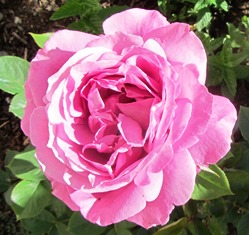
This candy-stripe rose requires a good pruning in the fall to generate a large bush with beautiful blooms in the spring
Remove leaves and prune back roses to 12 to 18 inches. Add some bone meal to the base of the bush and work into the soil.
Plant bulbs that will flower in the spring such as daffodils, tulips, hyacinth, crocus, and scillas.
Prepare a bed for onion seedlings or sets and plant them now for spring harvesting.
Fill bird feeders, hang a warming light in your hen house for the freezing nights ahead, and put blankets around your bee hives.
Transfer potted mums into garden soil. Most are perennials and will return year after year.
Plant kale, ornamental cabbage, and winter-hardy plants such as pansies in the garden or window boxes for winter color.
Move cold-sensitive houseplants indoors.
Protecting Your Backyard Flock in a Heat Wave
I lost a chicken this morning despite taking measures to protect her from the deadly heat wave we’ve been having here in the Bay Area. The last thing someone attached to their hens ever wants to see is one of her precious little girls gone. Mine was a Silver Laced Wyandotte (who leaves behind a sister) and five other hens with whom she was raised.
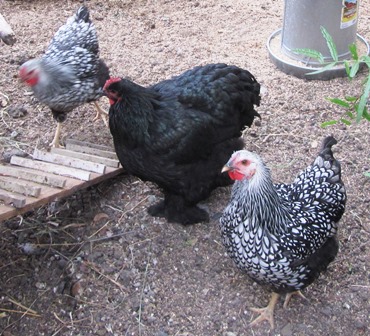
The Silver Laced Wyandotte (black-and-white) hen in the foreground succumbed to the extreme heat sometime during the night
Our farmette sits in the east bay hills and too far inland from the San Francisco Bay or the delta (which flows to Sacramento) to gain much benefit from cooling breezes off the ocean. We’ve had triple digit temps on the farmette for days.
I put out extra water basins for my chickens, kept their doors open in the chicken house at night (there is a wire run with a wire ceiling to protect them when they’d rather roost outside), and fed them frozen corn, cool seedless watermelon treats, and chilled grapes.
The chicken house has windows that I keep open (they have reinforced wire over the screens). I reduced the amount of litter on the floor (I use ground corn cob) since it could hold the heat.
I haven’t install a fogging system or fans, but I might if this heat keeps up.
The only telltale sign that my hen was in trouble was that she seemed to exhibit lethargy and to have lost weight (although it was difficult to tell under all her feathers).
Her comb had turned slightly pale and seemed to have shrunk in the last 24 hours. When I check on her last night she was turning herself to face the wall. Not a good sign since, in my experience, I’ve seen chickens do this before they pass away.
Some strategies for helping backyard chickens survive extreme heat include the following tips.
Eight Strategies to Help Chickens Beat the Heat
1. Make sure windows of chicken houses face north to south to allow breezes to blow through, rather than face east to west (rising and setting sun).
2. Keep litter on the chicken house floor low (1 to 2 inches is sufficient).
3. Position your chicken house under a tree, if possible, where the structure receives shade.
4. Make certain you have several watering dispensers (placed in the shade) with clean, fresh water every day during hot weather.
5. Add ice cubes to the watering canisters.
6. Put out treats such as bowls of frozen corn and cool, seedless watermelon, and chilled grapes or blueberries.
7. Use a fan, if necessary to remove heat from the chicken house.
8. As an emergency measure for a chicken that looks distressed, dip her in cool water.
Drying Fruits Naturally
I love dried apricots, but don’t tolerate well the ones treated with sulfur dioxide(used to prevent oxidation and loss of color). With so many apricots on our property coming ripe at once, I have decided in addition to making jam this year to also dry some of the fruit.
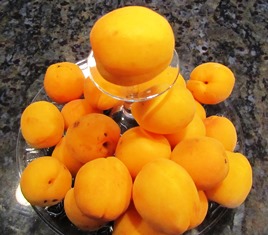
Apricots, so plentiful this time of year, are easy to dry and make great snacks when the season is over
Apricots dried but not treated with sulfur dioxide will turn a natural brown color. Some stores sell them this way. They are usually priced the same or similar to the treated apricots with the bright orange hue.
Besides apricots, other fruits that dry well include apples, bananas, cherries, grapes, nectarines, peaches, pears, plum, rhubarb, and even strawberries. You can use a drying machine
Quick Tips for Drying Fruit
1. Choose to dry only the freshest picked fruits, without bruises, scale, sun scald, or other blight.
2. Spray nonstick vegetable spray on drying pans or trays to make it easier to remove the dried fruit
3. Lay out the fruit to dry in a single layer on trays. Remember to rotate the trays occasionally and turn the pieces from time to time.
4. Destroy any insects (miniscule or otherwise) by freezing or baking the fruit. Simply take the tray and stick it into an oven heated to 175 degrees Fahrenheit for about 15 minutes. Alternatively, pack the dried fruit in freezer bags and freeze for at least 2 days.
5. Freezing dried fruit in resealable freezer bags will preserve its shelf life.
 Facebook
Facebook Goodreads
Goodreads LinkedIn
LinkedIn Meera Lester
Meera Lester Twitter
Twitter







